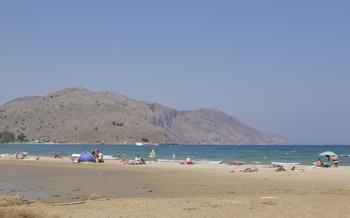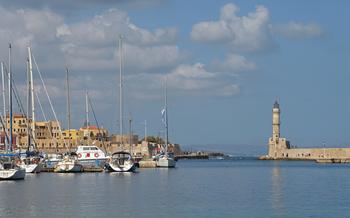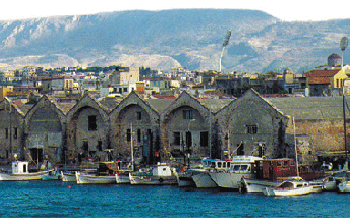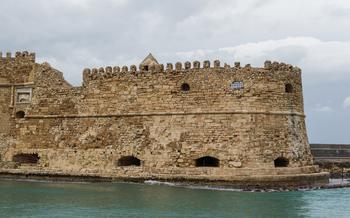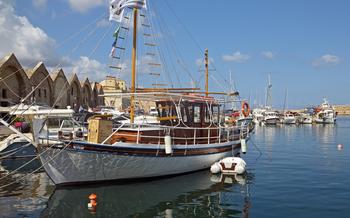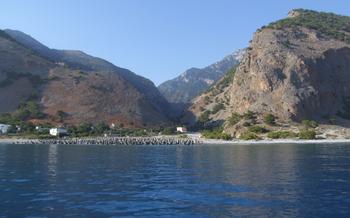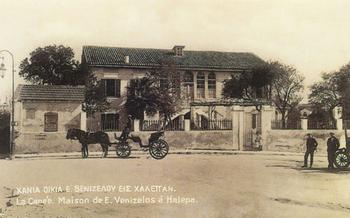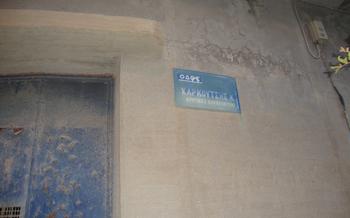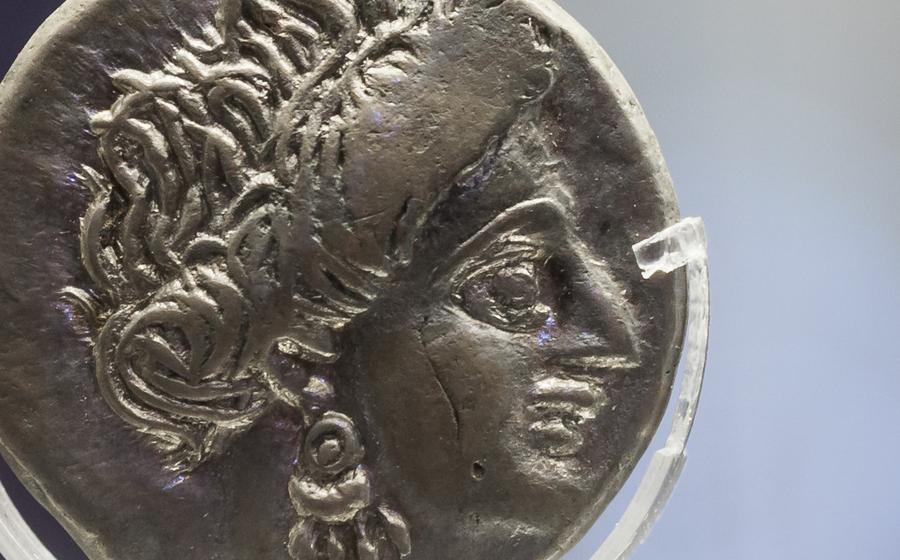
Ancient City of Kydonia
- The Antiquity of Kydonia: A Journey Through Time
- Unveiling the Ruins: A Glimpse into Kydonia's Legacy
- A Stroll Through the Old Town: Blending History and Modernity
- The Maritime Museum of Crete: Embracing the Seafaring Heritage
- Exploring the Venetian Harbor: A Legacy of Maritime Prowess
- The Municipal Market: A Feast for the Senses
- The Cathedral of the Assumption: A Symbol of Faith and History
- The Firkas Fortress: A Guardian of the City
- The Nea Chora District: A Fusion of Cultures
- The Minoan Settlement at Kastelli: Unveiling Ancient Roots
- The Samaria Gorge: A Natural Wonder Awaits
- The Balos Lagoon: A Paradise on Earth
- Insider Tip: Experience the Magic of Chania at Night
The Antiquity of Kydonia: A Journey Through Time
Kydonia, an ancient city of remarkable significance, played a pivotal role in the history of Crete. With roots tracing back to the Minoan era, Kydonia flourished as a prominent city-state in the Classical and Hellenistic periods. It was renowned for its strategic location, serving as a gateway between Crete and the Aegean Sea. Kydonia minted its coins, indicating its economic prosperity, and its name appears on various ancient maps and texts, attesting to its widespread recognition.
Key figures associated with Kydonia include the mythical hero Theseus, who is said to have visited the city during his travels. In the 3rd century BC, Kydonia allied with King Pyrrhus of Epirus in his campaign against Macedonia, further solidifying its political importance. Archaeological excavations have unearthed a wealth of artifacts, including pottery, tools, and inscriptions, providing valuable insights into Kydonia's vibrant past.
Unveiling the Ruins: A Glimpse into Kydonia's Legacy
Kydonia's ruins stand as tangible remnants of its glorious past, inviting visitors to embark on a journey through time. Among the notable structures, the Roman theater captivates with its well-preserved seating rows and stage, offering a glimpse into the city's vibrant entertainment scene. The Venetian fortifications, with their imposing walls and bastions, speak of Kydonia's strategic importance during the Venetian era. Furthermore, the Minoan settlement, with its unearthed foundations and artifacts, provides a fascinating link to the island's ancient civilization, shedding light on the city's enduring legacy.
As you wander through the ruins, intricate mosaic art adorns the floors of ancient buildings, depicting mythological scenes and geometric patterns. Architectural elements, such as columns, pediments, and archways, reveal the city's refined craftsmanship and artistic sensibilities. These remnants serve as silent witnesses to Kydonia's rich history, allowing visitors to piece together the fragments of a once-thriving city.
A Stroll Through the Old Town: Blending History and Modernity
Chania's Old Town is a captivating labyrinth of narrow streets, charming squares, and historic buildings, offering a unique blend of history and modernity. Begin your journey at the Venetian harbor, a picturesque waterfront lined with colorful buildings, outdoor cafes, and restaurants. Admire the Venetian architecture, with its elegant arches, stone facades, and intricate carvings. Stroll past the imposing Venetian fortifications, including the Firkas Fortress and the Sabbionara Bastion, which once protected the city from invaders.
Delve deeper into the Old Town, exploring the charming streets and alleys that lead to hidden courtyards and secret gardens. Discover historical landmarks such as the majestic Cathedral of the Assumption, with its Byzantine and Venetian influences, and the Mosque of the Janissaries, a testament to the city's multicultural past. Visit the Municipal Market, where local vendors sell fresh produce, herbs, spices, and traditional Cretan delicacies, creating a vibrant atmosphere that engages all the senses.
Chania's Old Town is a place where history and modernity intertwine. Stroll along the narrow streets, admiring the restored Venetian mansions that now house stylish boutiques, art galleries, and traditional tavernas. Take a break at a local cafe, savoring a cup of Greek coffee while watching the world go by. The Old Town comes alive at night, with locals and visitors alike filling the streets, enjoying the vibrant nightlife, and discovering the many hidden gems that this enchanting neighborhood has to offer.
The Maritime Museum of Crete: Embracing the Seafaring Heritage
Chania's maritime history is a rich tapestry of seafaring exploits, naval battles, and trading endeavors. The Maritime Museum of Crete, housed in the Venetian Arsenals, pays homage to this glorious past. Its collection showcases ship models, navigational instruments, and artifacts recovered from shipwrecks, offering a glimpse into the maritime heritage of the region. Visitors can learn about the significance of Chania as a major port city in the Mediterranean, its role in trade and exploration, and the challenges faced by sailors navigating the treacherous seas. The museum provides a fascinating journey through centuries of maritime history, shedding light on the crucial role of seafaring in shaping the cultural and economic development of Crete.
Exploring the Venetian Harbor: A Legacy of Maritime Prowess
Strolling along the picturesque Venetian Harbor of Chania is a journey back in time, where the legacy of maritime prowess unfolds at every corner. The harbor, once a strategic naval base for the Venetian Republic, is a testament to the city's rich maritime history. Admire the colorful buildings lining the waterfront, their pastel hues reflecting in the shimmering waters. The Venetian architecture, with its Gothic arches and ornate facades, adds to the harbor's timeless charm. Explore the Venetian fortifications, remnants of a bygone era when Chania stood as a formidable maritime power. Take a moment to relax at one of the harbor's many inviting cafes or restaurants, savoring a traditional Cretan meal while enjoying panoramic views of the sparkling harbor and the distant horizon. The Venetian Harbor of Chania is a living testament to the city's deep-rooted connection to the sea, a place where history and beauty converge in perfect harmony.
The Municipal Market: A Feast for the Senses
Prepare to immerse yourself in a sensory extravaganza as you step into Chania's central market, a vibrant hub of local life and culinary delights. The air fills with the heady aroma of fresh produce, herbs, and spices, tantalizing your senses and inviting you to explore the treasures within.
Vendors proudly display their offerings, from mounds of ripe fruits and vegetables in every color of the rainbow to aromatic herbs, freshly picked from the nearby countryside. Discover the unique flavors of Crete, including sweet and juicy watermelons, crisp cucumbers, and fragrant tomatoes.
Indulge in the local delicacies that line the market stalls. Sample the famous Cretan cheeses, such as creamy graviera and tangy mizithra, or savor the sweet pastries and traditional sweets, a testament to the island's rich culinary heritage.
Engage with the friendly locals, who are always happy to share their knowledge and passion for Cretan cuisine. Learn about the traditional uses of herbs and spices, and gather tips for cooking authentic Cretan dishes.
Uncover hidden culinary gems, such as wild greens foraged from the mountains or locally produced honey with a distinct floral aroma. Immerse yourself in the vibrant atmosphere of the market, where the buzz of conversation and the clinking of glasses create a lively symphony of sounds.
As you wander through the market, let your senses guide you and embrace the opportunity to experience the true essence of Chania, where the flavors, aromas, and traditions of Crete come together in a symphony of delight.
The Cathedral of the Assumption: A Symbol of Faith and History
Towering over the heart of Chania's Old Town, the Cathedral of the Assumption stands as a testament to the city's rich religious and historical heritage. This grand edifice, a blend of Byzantine and Venetian architectural influences, is a must-visit for anyone seeking a deeper understanding of Chania's past.
Originally built in the 14th century by the Venetians, the Cathedral of the Assumption underwent several modifications and additions over the centuries, reflecting the city's changing rulers and artistic movements. Its imposing facade, adorned with intricate carvings and sculptures, hints at the treasures that lie within.
Step inside the cathedral, and you'll be awed by its spacious interior, illuminated by the warm glow of flickering candles. The walls are adorned with beautiful religious icons and artwork depicting biblical scenes, each telling a story of faith and devotion. The iconostasis, a finely crafted screen separating the nave from the sanctuary, is a masterpiece in itself, showcasing exquisite craftsmanship and artistry.
Beyond its religious significance, the Cathedral of the Assumption also holds historical importance. It served as the seat of the Catholic Archdiocese of Crete during Venetian rule and later became the Orthodox Cathedral of Chania after the Ottoman conquest. These transitions have left an indelible mark on the building's architecture and atmosphere, creating a unique blend of religious influences.
Take some time to explore the cathedral's surroundings as well. The adjacent square, known as Plateia Mitropoleos, is a popular gathering place for locals and visitors alike, offering panoramic views of the city and the Venetian harbor.
Whether you're a history buff, an architecture enthusiast, or simply someone seeking spiritual inspiration, the Cathedral of the Assumption is a must-visit destination in Chania, offering a glimpse into the city's rich past and its enduring faith.
The Firkas Fortress: A Guardian of the City
Overlooking the picturesque Venetian harbor, the imposing Firkas Fortress stands as a testament to Chania's rich history. Initially constructed by the Venetians in the 14th century, this formidable fortress served as a crucial defensive outpost against invading forces. Its strategic location at the entrance to the harbor made it a key player in protecting the city from maritime threats.
As you approach the fortress, its massive stone walls and ramparts create an awe-inspiring sight. Step inside to explore its well-preserved interior, where you'll find a labyrinth of narrow passages and dungeons that once held prisoners. The fortress's architecture reflects the ingenuity of Venetian military engineering, with its sturdy construction and clever defensive features.
Climb to the top of the fortress to be rewarded with breathtaking panoramic views of Chania and the surrounding landscape. The sparkling blue waters of the harbor, the terracotta-roofed houses of the Old Town, and the distant White Mountains create a picture-postcard panorama. Take a moment to soak in the beauty of this historic city, framed by the ramparts of the Firkas Fortress.
The Nea Chora District: A Fusion of Cultures
In the Nea Chora district, history and culture intertwine, creating a vibrant tapestry of architectural styles and traditions. Once home to Chania's Muslim community, this neighborhood retains a unique character, with narrow streets, charming houses, and a rich blend of architectural elements. Explore the alleys and discover hidden gems, such as the Giali Tzami mosque, a reminder of the city's Ottoman past.
Visit the Municipal Market, a bustling hub of activity where vendors sell fresh produce, herbs, spices, and traditional Cretan delicacies. Engage with the locals and immerse yourself in the culinary treasures of the island.
As evening falls, Nea Chora transforms into a lively hub of nightlife, with trendy cafes, bars, and restaurants lining the streets. Enjoy a leisurely dinner at a traditional taverna, accompanied by live music and the warm hospitality of the locals.
Nea Chora is a district that epitomizes the harmonious coexistence of different cultures, a testament to Chania's rich and diverse history.
The Minoan Settlement at Kastelli: Unveiling Ancient Roots
Just a short distance from Chania lies the archaeological site of Kastelli, a testament to the ancient Minoan civilization that once thrived on Crete. As you step into the site, you'll be transported back in time to the Bronze Age, where the Minoans built a significant settlement.
Explore the well-preserved remains of their homes, workshops, and storage facilities, and marvel at the intricate Minoan architecture. Discover the secrets of their daily lives as you wander through the narrow streets, imagining the bustling activity that once filled this ancient city.
At Kastelli, you'll find evidence of the Minoans' advanced culture. Admire the finely crafted pottery, stone tools, and jewelry that have been unearthed here, showcasing their skills in craftsmanship. Learn about their religious beliefs and rituals as you explore the remains of their shrines and sacred spaces.
Kastelli offers a glimpse into the origins of Cretan civilization and the Minoan era. As you walk among the ruins, you'll gain a deeper appreciation for the rich history and cultural heritage of this fascinating island.
The Samaria Gorge: A Natural Wonder Awaits
Crete, the largest of the Greek islands, boasts a diverse landscape that includes the Samaria Gorge, one of Europe's longest gorges. Located in the southwest of the island, this natural wonder attracts hikers and nature enthusiasts from around the world.
Spanning 18 kilometers in length, the Samaria Gorge offers a challenging yet rewarding hiking experience. The trail winds through stunning scenery, towering cliffs, and lush vegetation, providing breathtaking views at every turn. As you descend into the gorge, you'll encounter various ecosystems, from pine forests to Mediterranean scrubland, each teeming with diverse wildlife.
The hike through the Samaria Gorge typically takes between 4 and 7 hours, depending on your pace and fitness level. Along the way, you'll encounter several resting points where you can take a break, enjoy a picnic lunch, and replenish your water supplies. The trail is well-maintained and marked, making it suitable for hikers of all skill levels.
The highlight of the hike is undoubtedly the Iron Gates, a narrow passage where the gorge walls rise to over 300 meters on either side. Here, you'll feel dwarfed by the sheer scale of nature's majesty. The gorge culminates at the Libyan Sea, where you can cool off with a refreshing swim in the crystal-clear waters.
Hiking the Samaria Gorge is an unforgettable experience that combines physical challenge with breathtaking natural beauty. Remember to wear comfortable hiking shoes, bring plenty of water, and start your hike early to avoid the midday heat. If you're feeling adventurous, consider camping overnight in the gorge to fully immerse yourself in its tranquility.
The Balos Lagoon: A Paradise on Earth
Venture beyond Chania to discover the enchanting Balos Lagoon, a natural paradise that will leave you spellbound. Located on the west coast of Crete, this breathtaking lagoon is a sanctuary of turquoise waters, pristine white-sand beaches, and awe-inspiring scenery. As you approach, you'll be captivated by the lagoon's ethereal beauty, a true testament to nature's artistry.
Immerse yourself in the crystal-clear waters, perfect for swimming and snorkeling. Dive into the underwater world and encounter a vibrant array of marine life, from colorful fish to playful dolphins. The shallow waters provide a safe and enjoyable experience for swimmers of all levels, making it an ideal destination for families with children.
Relax on the pristine beach, basking in the warm Mediterranean sun. Feel the soft sand beneath your feet as you soak up the breathtaking views. The tranquil atmosphere and stunning surroundings create the perfect setting for a day of relaxation and rejuvenation.
Don't miss the opportunity to explore the lagoon's hidden corners and discover its secluded coves. Take a leisurely walk along the shoreline, marveling at the rugged cliffs and rock formations that surround this natural paradise. The Balos Lagoon is not just a destination; it's an experience that will stay with you long after you leave its shores.
Insider Tip: Experience the Magic of Chania at Night
As the sun sets over Chania, a new world of enchantment unfolds. The city transforms into a vibrant tapestry of lights and sounds, beckoning visitors to explore its hidden gems. Take a leisurely stroll along the moonlit harbor, where the Venetian architecture takes on a mystical aura. Discover secluded courtyards and secret alleys, where local musicians serenade passersby with traditional melodies. Indulge in culinary delights at one of the many tavernas, where the flavors of Crete come alive under the starlit sky. As the night progresses, let the infectious energy of Chania sweep you away, whether you choose to dance the night away at a lively club or simply bask in the tranquility of the city's hidden corners. Embrace the magic of Chania at night, and create memories that will last a lifetime.
